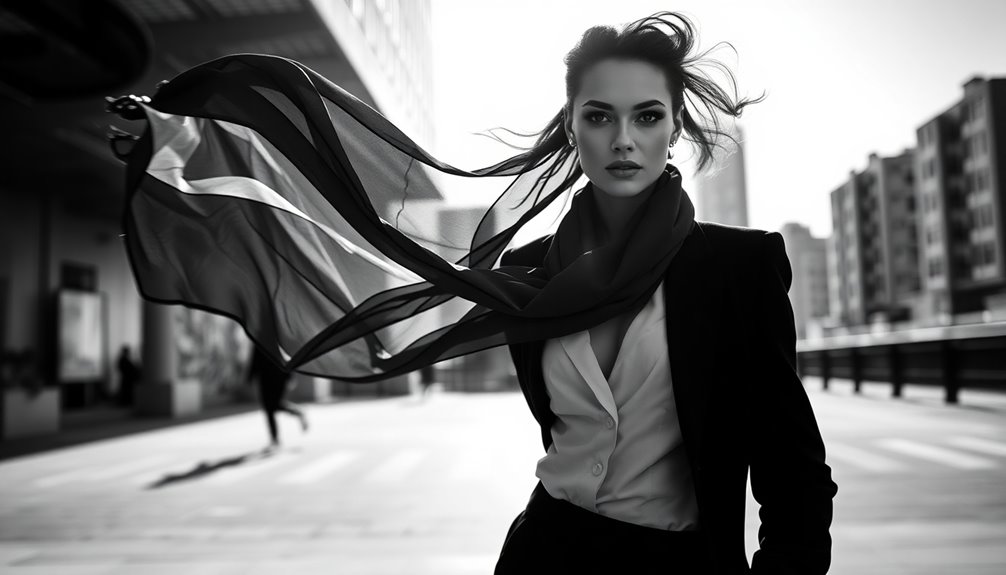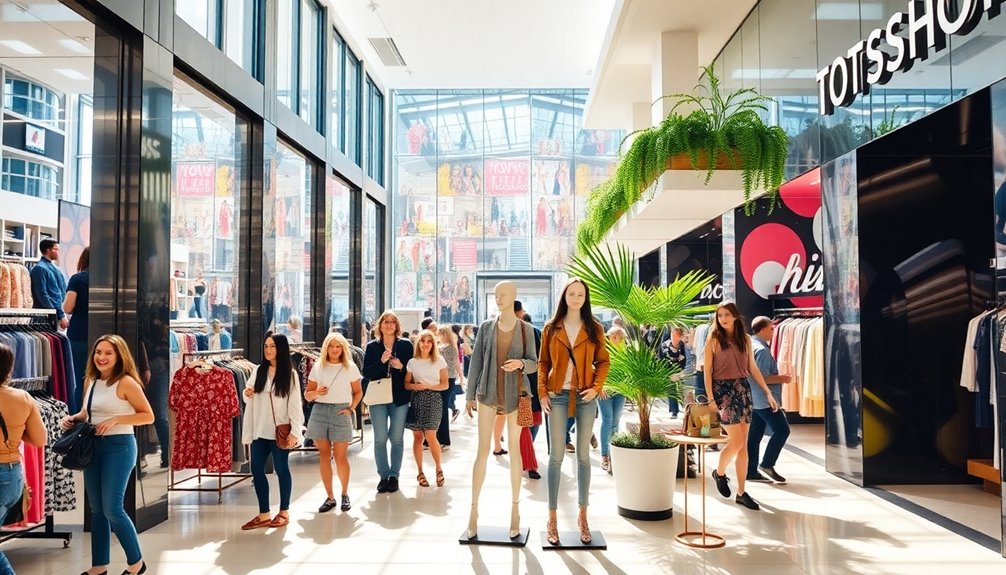If you're looking for inspiration in fashion photography, don't miss icons like Annie Leibovitz, Steven Meisel, and Patrick Demarchelier. Leibovitz's bold compositions and dramatic lighting redefine fashion narratives. Meisel's avant-garde style showcases diverse perspectives, while Demarchelier's timeless elegance captures genuine emotions. Each photographer offers a unique lens, reflecting current trends like authenticity and inclusivity, making their work vital in today's industry. Additionally, explore mobile-first techniques and sustainable practices to enhance your own photography. There's a lot more to uncover that can ignite your creative spark and keep you inspired!
Key Takeaways
- Annie Leibovitz: Known for her dramatic lighting and bold compositions, she has redefined fashion photography and captured iconic moments for leading publications.
- Steven Meisel: A pivotal figure in fashion photography, he is celebrated for his avant-garde style and has launched the careers of numerous supermodels.
- Patrick Demarchelier: Renowned for his timeless aesthetic, he has created iconic images for luxury brands and magazines, reflecting understated elegance.
- Current Trends: Emphasizing authenticity and relatable imagery, top photographers are breaking conventional rules to align with the cultural zeitgeist.
- Diverse Representation: Inclusive casting of models from various backgrounds enriches fashion narratives and promotes a more authentic and relatable visual storytelling.
Annie Leibovitz
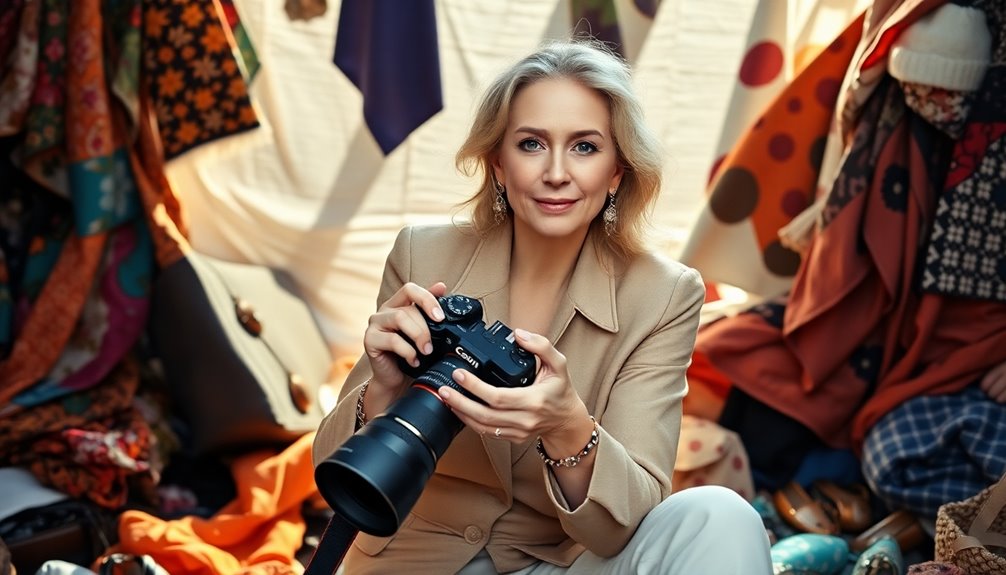
Annie Leibovitz's unique vision has redefined fashion photography, making her one of the most influential photographers of our time. You might recognize her dramatic lighting and bold compositions that capture the essence of her subjects.
Starting her career as a photojournalist for Rolling Stone in 1970, she rose to become the magazine's chief photographer by 1973, breaking barriers as the first female to hold this position. Chief photographer for Rolling Stone at a young age, she set a precedent for women in photography.
Joining Vanity Fair in 1983 and collaborating with Vogue in the late 1980s, she photographed iconic figures like John Lennon and Yoko Ono. Her work often combines vivid color with carefully staged settings, revealing both intimate and candid moments.
You'll find her style described as "painterly," focusing on the human spirit rather than just fashion.
Leibovitz's notable projects include the iconic "Demis" photograph of a nude, pregnant Demi Moore and campaigns for brands like Nike and Disney.
Recognized with numerous awards, including the Lifetime Achievement Award from the International Center of Photography, she's also been designated a Living Legend by the Library of Congress.
Her captivating work continues to inspire photographers around the world.
Steven Meisel

With a career spanning several decades, Steven Meisel is a powerhouse in the fashion photography world. Born in 1954, he honed his artistic skills at the High School of Art and Design in New York City and later majored in Fashion Illustration at Parsons.
Meisel initially worked as an illustrator for Halston before transitioning to photography, drawing inspiration from legends like Jerry Schatzberg and Richard Avedon. His first photography opportunity came through Elite Model Management models, marking the beginning of his significant impact in the industry.
As the primary photographer for American and Italian Vogue since the late 1980s, Meisel's work has defined countless campaigns for prestigious brands like Prada, Versace, and Calvin Klein. His iconic advertisements, which often blur the lines between art and fashion, have made statements that resonate beyond the industry.
He's known for his avant-garde style, infusing social commentary into his thought-provoking editorials, such as the groundbreaking all-black issue of Italian Vogue in 2008.
Meisel's impact on the fashion world is profound; he's launched the careers of supermodels like Naomi Campbell and Karlie Kloss. His photographs continue to inspire and challenge perceptions, ensuring his legacy endures in the vibrant realm of fashion photography.
Patrick Demarchelier

Renowned for his understated elegance and timeless aesthetic, Patrick Demarchelier has left an indelible mark on the fashion photography landscape. Born in 1943 in Le Havre, France, he began his journey at 17 when he received a Kodak Eastman camera. After moving to Paris in 1963, he honed his skills in darkrooms and assisted established photographers. His big break came when he started taking test shots for models at Paris Planning, leading to major assignments for top magazines like *Vogue* and *Harper's Bazaar*.
Demarchelier's eye for simplicity and elegance shines through in his work. He eschewed ornate backdrops, favoring natural settings that enhance the personality of his subjects. His notable collaborations include iconic images of Princess Diana and campaigns for luxury brands like Dior and Chanel. His ability to capture the essence of fashion has earned him praise from industry leaders, including Anna Wintour, who lauded his knack for taking "simple photographs perfectly." In 1992, he established himself as principal photographer for *Harper's Bazaar*, further solidifying his influence in the industry.
Throughout his career, Demarchelier has received numerous accolades, including being named an Officer of Arts and Letters by the French government in 2007, solidifying his legacy in the world of fashion photography.
Photography Styles and Trends
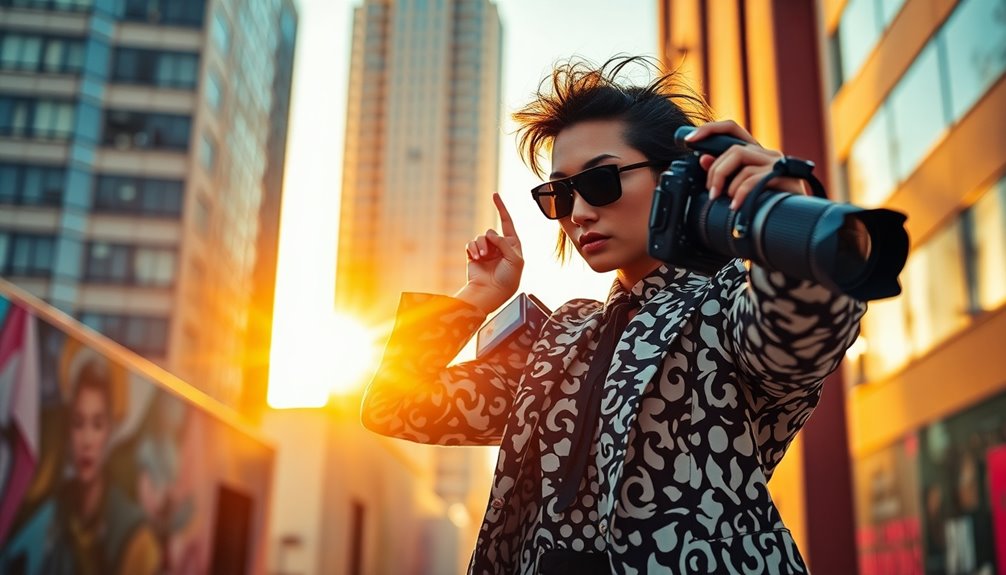
Fashion photography is constantly evolving, reflecting the shifting dynamics of society and culture. One prominent trend is the retro and vintage aesthetic. You'll notice grainy textures and faded colors, reminiscent of classic film photography, which adds a timeless feel to your images. This style is perfect for editorial work or personal projects, allowing you to embrace imperfections. Photography trends evoke emotional responses through timeless visuals, enhancing the viewer's connection to the subject.
Another essential trend is inclusive and authentic photography. Brands are demanding diverse representation, showcasing models of various races, ages, body types, and abilities. You should focus on capturing natural expressions and candid moments with minimal retouching, making everyone feel seen.
In addition, bold and moody color schemes dominate today's visual landscape. Bright, saturated tones evoke strong emotions, while shadowy, desaturated colors create a moody atmosphere, ideal for storytelling. Experimenting with these palettes can elevate your fashion work.
Lastly, advanced techniques like panoramic and underwater photography are gaining popularity. Incorporating motion photography emphasizes action, while AI-driven tools streamline your editing process.
Sustainable Practices in Photography
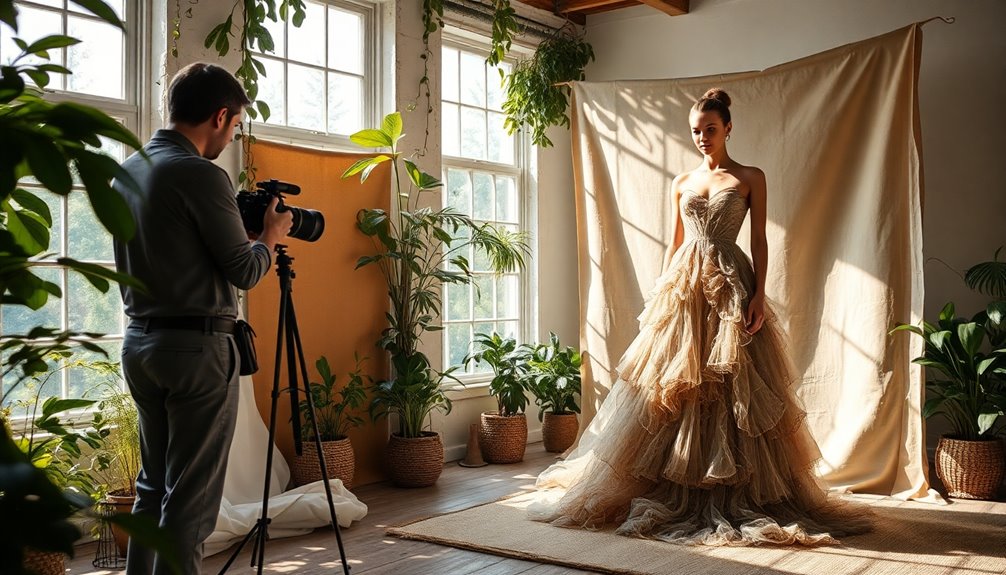
Sustainably-minded photographers often seek innovative ways to minimize their environmental impact while still creating stunning visuals. One effective strategy is renting or borrowing props and wardrobe items, which helps reduce waste and saves money.
Collaborating with fellow photographers or stylists can also lead to shared resources, amplifying your creative potential while being eco-conscious. Fashion rental services are great for sourcing garments, allowing you to extend the lifespan of clothing without contributing to fast fashion waste.
Embracing natural light can significantly cut down on energy consumption. Make it a habit to switch off studio lights when they're not in use, optimizing natural light sources to further minimize your reliance on artificial lighting. Additionally, consider using reflectors to enhance natural light without artificial sources for even better results.
When it comes to materials, choose props made from organic fabrics, recycled materials, or upcycled items. Opt for eco-friendly makeup and hair products, and always use cleaning products that are gentle on the environment.
Lastly, implement recycling and composting bins on set, and encourage your team to minimize excessive packaging and avoid single-use items. Every small change counts toward a more sustainable future in photography.
Authenticity in Fashion Photography
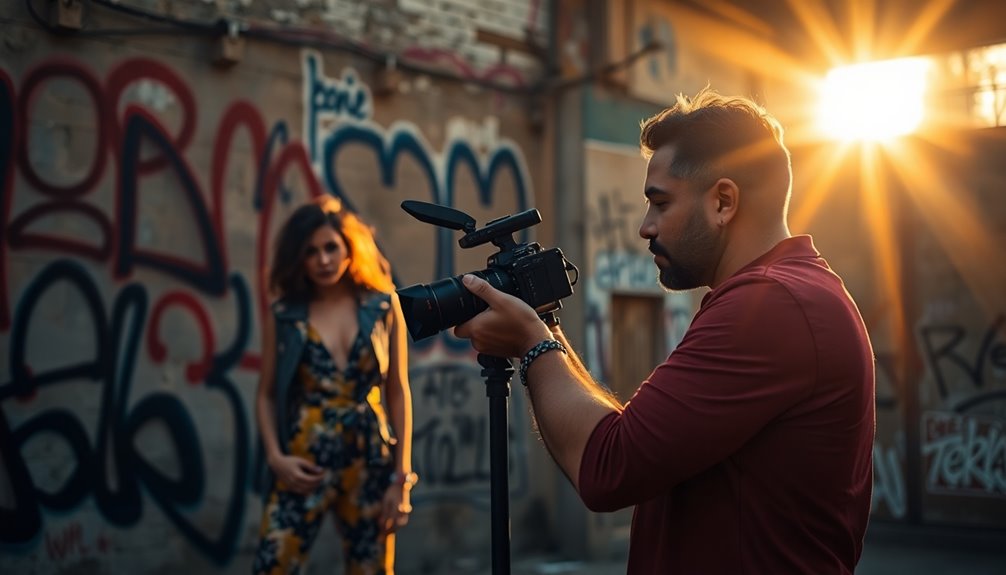
Authenticity in fashion photography is vital for capturing the genuine essence of subjects, allowing their true character to shine through. By promoting authenticity, you raise the standard of your work and encourage thoughtfulness in every shot. This approach captures the real narratives of your subjects, creating deeper connections between viewers and images.
Avoiding overly retouched photos helps dismantle unrealistic beauty standards and fosters a more relatable representation.
When you focus on authentic imagery, you evoke stronger emotional responses. Real emotions and natural expressions resonate with audiences, making your work more impactful. Emphasizing the subject's natural beauty allows for more satisfying photographs that viewers can connect with.
To achieve authenticity, aim to capture more of the shot in-camera and on location. Use minimal makeup, letting your model's true emotions shine through. Pay careful attention to composition, ensuring all elements in the frame enhance the natural look. Authentic experiences in visuals increase relatability and understanding, reinforcing the importance of genuine representation.
Experimenting with various angles and appropriate lenses can also emphasize authenticity.
As the industry embraces this trend, top photographers are recognized for their ability to break conventional rules and reflect the zeitgeist of our times. Authenticity isn't just a style; it's a movement toward genuine representation.
Mobile-First Photography Techniques
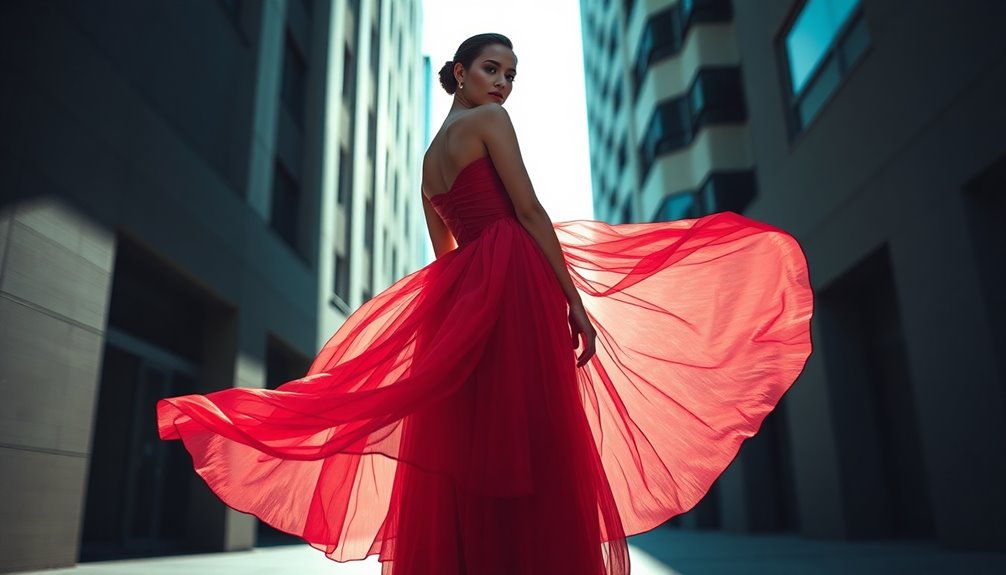
Capturing stunning images on mobile devices has become more accessible, enabling anyone to embrace their creativity without the need for professional gear. Start by planning your shoot with a mood board, using tools like Pinterest to gather inspiration. Define your theme and style, and choose optimal lighting times—early morning or late afternoon—for the best results.
When it comes to lighting and composition, natural light is your friend. Position your model near windows to avoid harsh shadows. Use gridlines on your phone for balanced framing, applying the Rule of Thirds. Experiment with wide-angle settings for added depth. Incorporate simple backgrounds to avoid distractions that can detract from your subject.
In focusing and camera techniques, rely on your phone's autofocus but manually tap on the subject's face to ensure sharpness. Explore various angles, including low and high shots, for unique perspectives. Be cautious with distance to avoid distortion.
Lastly, keep props minimal and encourage dynamic poses to add life to your shots. Use editing apps like VSCO for quick adjustments and Adobe Photoshop Express for in-depth retouching, ensuring your images maintain their detail and vibrancy.
With these mobile-first techniques, you can create captivating fashion photography right from your pocket.
Inclusive Representation in Photography
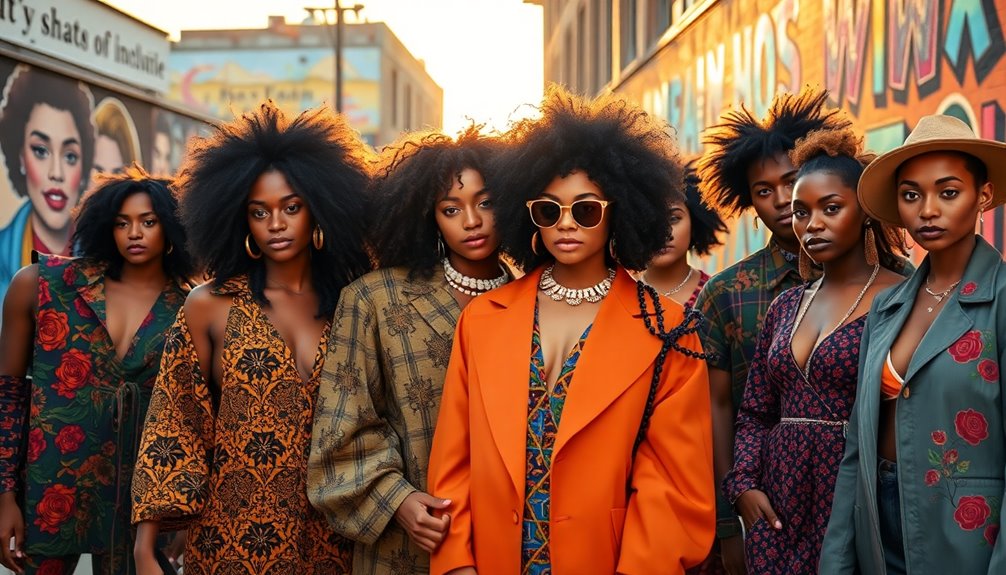
In today's fashion photography landscape, embracing inclusive representation isn't just a trend—it's essential. You should actively seek to cast diverse models, representing various ethnicities, genders, ages, and body types. This approach showcases a broader vision of fashion, breaking away from narrow beauty standards. Including models with physical disabilities promotes accessibility and challenges stereotypes, fostering a positive body image. Diverse model casting not only enriches the visual narrative but also resonates with audiences seeking authenticity in representation.
Collaboration is key. Work with underrepresented creatives like hair and makeup artists and stylists who understand and celebrate diverse cultures. Partner with agencies that prioritize diversity to access a rich pool of talent. This will help you create looks that resonate with a wide audience and reflect the beauty of different backgrounds.
Selecting diverse locations can also enhance your storytelling. Choose settings that highlight unique cultural elements and resonate with various communities. These choices enrich your imagery and promote a more realistic representation of beauty.
Finally, highlight the unique stories of your models. Celebrate their perspectives and experiences, using positive language that uplifts rather than reinforces negative stereotypes. Listening to their feedback can only improve your work and help you create a more inclusive fashion narrative.
Emotional Portraiture Insights
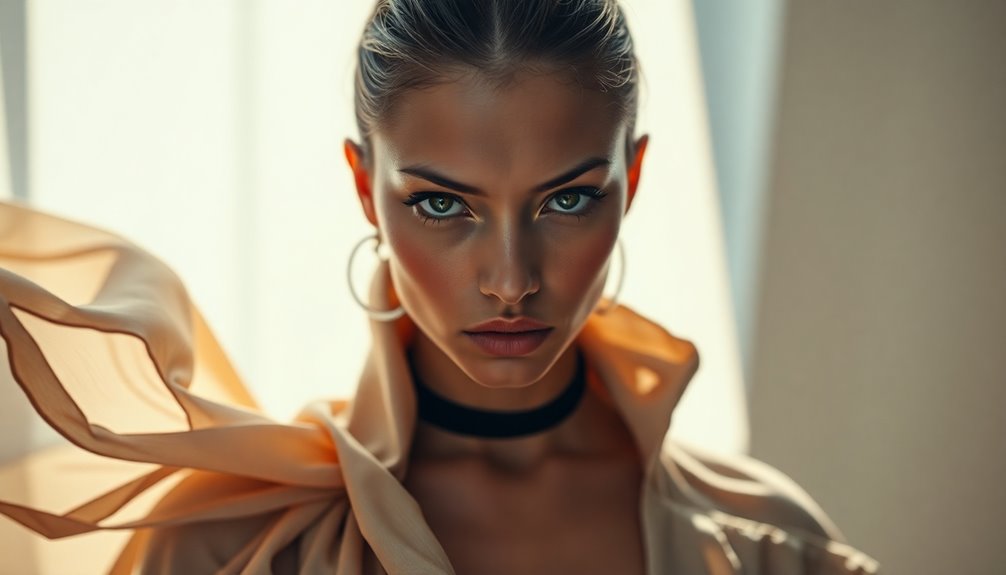
Creating emotional portraits requires a deep connection between you and your subject. Start by building rapport and trust; engage in dialogue and ask questions to help them feel comfortable. Allow your subjects time to let their guard down, revealing their true selves. Light-hearted banter can ease tension, and showing the back of the camera can make the experience more relaxed.
Lighting plays a crucial role in conveying emotion. Keep it simple to maintain focus on your subject. Experiment with different lighting setups; for example, use butterfly lighting for happiness and short lighting for sadness. Adjust shadows and highlights to add depth and support the emotional story. Choosing the right lighting pattern can significantly enhance the mood of your portraits.
To capture authentic expressions, encourage your subjects to act instead of pose. Direct them to look away for somber moments, and don't hesitate to capture candid outtakes for those spontaneous emotions. Pay attention to body language and posture, as these elements enhance the overall impact.
Lastly, think creatively with your angles. Shooting from eye level fosters intimacy, while higher angles can evoke vulnerability. Use props and settings to enrich the emotional narrative, ensuring every element contributes to the story you want to tell.
Frequently Asked Questions
What Equipment Do Top Fashion Photographers Typically Use?
Top fashion photographers often rely on high-quality equipment to capture stunning images.
You'll find them using cameras like the Nikon D850 or Canon EOS R5 for their exceptional detail and performance.
Lighting plays a crucial role, too; they utilize Profoto B1X flashes, softboxes, and reflectors to create the perfect ambiance.
Don't forget about backdrops and lighting stands, which help set the scene and stabilize their gear for flawless shots.
How Can Aspiring Photographers Break Into the Fashion Industry?
To break into the fashion industry, start by taking photography courses to master your skills.
Volunteer with established photographers and collaborate with local models to build your portfolio.
Get active on social media to showcase your work and connect with industry professionals.
Attend fashion events to network and stay updated on trends.
Lastly, consider creating a website to display your portfolio, making it easier for potential clients to find and hire you.
What Are Common Challenges Faced by Fashion Photographers?
As a fashion photographer, you'll face various challenges.
You'll need to unite different creative visions while managing relationships with models, stylists, and makeup artists. Technical issues like capturing accurate colors and proper lighting can be tricky, too.
During pre-production, ensuring garments are photo-ready is essential. Plus, navigating the industry's demands and building a recognizable portfolio can be overwhelming.
Staying adaptable and maintaining clear communication with your team will help you succeed.
How Do Fashion Photographers Collaborate With Designers and Brands?
Fashion photographers collaborate closely with designers and brands to capture their vision and aesthetic. Famous fashion photographers have the unique ability to understand and interpret the creative direction of designers and brands, ultimately bringing their ideas to life through visually compelling images. Through close collaboration, these photographers carefully consider lighting, poses, and angles to convey the essence of a garment or collection. The end result is a powerful visual narrative that showcases the unique style and vision of the designer or brand.
You'll see them working together on campaigns, lookbooks, and behind-the-scenes documentation. Through these partnerships, photographers gain unique access to the design process, showcasing creativity and brand identity.
By combining their artistic styles, they create striking imagery that resonates with audiences and boosts brand recognition.
This collaborative effort enhances both the fashion and photography worlds, making them more dynamic and engaging.
What Role Does Post-Production Play in Fashion Photography?
Post-production plays a crucial role in fashion photography by enhancing the aesthetic appeal of your images.
You adjust brightness, contrast, and colors to create a cohesive look that aligns with the designer's vision.
Retouching helps you eliminate imperfections while preserving the model's natural features.
Advanced techniques ensure consistency across the series, making sure every detail complements the overall theme.
Ultimately, it transforms your raw shots into polished, professional photographs that captivate your audience.
Conclusion
As you explore the world of fashion photography, let these trailblazing photographers inspire your creative journey. Remember to embrace diverse styles, sustainable practices, and authentic storytelling in your work. Stay open to the evolving trends, like mobile-first techniques and inclusive representation, to keep your perspective fresh and relevant. Ultimately, capturing genuine emotions in your portraits will resonate with your audience and elevate your photography. So grab your camera and start creating!
